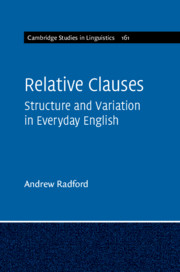4 - Gapless Relatives
Published online by Cambridge University Press: 10 June 2019
Summary
In this chapter, I take a critical look at a range of different analyses of gapless relatives, comparing syntactic and processing accounts.
I begin in §4.2 by exploring a number of syntactic accounts which suppose that (contrary to the claim that they are gapless), such structures involve relativisation of the object of a stranded preposition which is present in the syntax but receives a silent spellout at PF; e.g. on this view, which in (1a) could be analysed as the complement of a silent counterpart of the preposition over. In §4.3, I go on to consider an alternative silent preposition analysis proposed by Collins & Radford (2015) in which gapless relatives involve deletion of a fronted preposition. In §4.4, I consider a range of alternative analyses which posit that there is no silent preposition in (many) gapless relatives. In §4.5 I look at alternative processing accounts, and in §4.6 I present a summary of my overall findings.
- Type
- Chapter
- Information
- Relative ClausesStructure and Variation in Everyday English, pp. 191 - 242Publisher: Cambridge University PressPrint publication year: 2019

